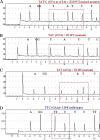Detection of E119V and E119I mutations in influenza A (H3N2) viruses isolated from an immunocompromised patient: challenges in diagnosis of oseltamivir resistance
- PMID: 20194700
- PMCID: PMC2863645
- DOI: 10.1128/AAC.01608-09
Detection of E119V and E119I mutations in influenza A (H3N2) viruses isolated from an immunocompromised patient: challenges in diagnosis of oseltamivir resistance
Abstract
The clinical use of the neuraminidase inhibitor (NAI) oseltamivir is associated with the emergence of drug resistance resulting from subtype-specific neuraminidase (NA) mutations. The influenza A/Texas/12/2007 (H3N2) virus isolated from an oseltamivir-treated immunocompromised patient exhibited reduced susceptibility to oseltamivir in the chemiluminescent neuraminidase inhibition (NI) assay (approximately 60-fold increase in its 50% inhibitory concentration [IC(50)] compared to that for a control virus). When further propagated in cell culture, the isolate maintained reduced susceptibility to oseltamivir in both chemiluminescent and fluorescent NI assays (approximately 50- and 350-fold increases in IC(50), respectively). Sequencing analysis of the isolate revealed a mix of nucleotides coding for amino acids at position 119 of the NA [E119(V/I)]. Plaque purification of the isolate yielded E119V and E119I variants, both exhibiting reduced susceptibility to oseltamivir. The E119I variant also showed decreased susceptibility to zanamivir and the investigational NAIs peramivir and A-315675. The emergence of E119V variants in oseltamivir-treated patients has been previously reported; however, the E119I mutation detected here is a novel one which reduces susceptibility to several NAIs. Both mutations were not detected in unpropagated original clinical specimens using either conventional sequencing or pyrosequencing, suggesting that these variants were present in very low proportions (<10%) in clinical specimens and gained dominance after virus propagation in MDCK cells. All virus isolates recovered from the patient were resistant to adamantanes. Our findings highlight the potential for emergence and persistence of multidrug-resistant influenza viruses in oseltamivir-treated immunocompromised subjects and also highlight challenges for drug resistance diagnosis due to the genetic instability of the virus population upon propagation in cell culture.
Figures

Similar articles
-
Cell culture-selected substitutions in influenza A(H3N2) neuraminidase affect drug susceptibility assessment.Antimicrob Agents Chemother. 2013 Dec;57(12):6141-6. doi: 10.1128/AAC.01364-13. Epub 2013 Sep 30. Antimicrob Agents Chemother. 2013. PMID: 24080660 Free PMC article.
-
Characterization of multidrug-resistant influenza A/H3N2 viruses shed during 1 year by an immunocompromised child.Clin Infect Dis. 2006 Dec 15;43(12):1555-61. doi: 10.1086/508777. Epub 2006 Nov 8. Clin Infect Dis. 2006. PMID: 17109288
-
Progressive emergence of an oseltamivir-resistant A(H3N2) virus over two courses of oseltamivir treatment in an immunocompromised paediatric patient.Influenza Other Respir Viruses. 2013 Nov;7(6):904-8. doi: 10.1111/irv.12108. Epub 2013 Mar 29. Influenza Other Respir Viruses. 2013. PMID: 23551973 Free PMC article.
-
Host cell selection of influenza neuraminidase variants: implications for drug resistance monitoring in A(H1N1) viruses.Antiviral Res. 2010 Feb;85(2):381-8. doi: 10.1016/j.antiviral.2009.11.005. Epub 2009 Nov 13. Antiviral Res. 2010. PMID: 19917319
-
Assays for monitoring susceptibility of influenza viruses to neuraminidase inhibitors.Influenza Other Respir Viruses. 2013 Jan;7 Suppl 1(Suppl 1):44-9. doi: 10.1111/irv.12051. Influenza Other Respir Viruses. 2013. PMID: 23279896 Free PMC article. Review.
Cited by
-
Application of a seven-target pyrosequencing assay to improve the detection of neuraminidase inhibitor-resistant Influenza A(H3N2) viruses.Antimicrob Agents Chemother. 2015 Apr;59(4):2374-9. doi: 10.1128/AAC.04939-14. Epub 2015 Feb 2. Antimicrob Agents Chemother. 2015. PMID: 25645846 Free PMC article.
-
Influenza B viruses with mutation in the neuraminidase active site, North Carolina, USA, 2010-11.Emerg Infect Dis. 2011 Nov;17(11):2043-6. doi: 10.3201/eid1711.110787. Emerg Infect Dis. 2011. PMID: 22099093 Free PMC article.
-
Genetic analysis of H3N2 avian influenza viruses isolated from live poultry markets and poultry slaughterhouses in Shanghai, China in 2013.Virus Genes. 2015 Aug;51(1):25-32. doi: 10.1007/s11262-015-1198-5. Epub 2015 Apr 22. Virus Genes. 2015. PMID: 25899857
-
A Novel Antiviral Target Structure Involved in the RNA Binding, Dimerization, and Nuclear Export Functions of the Influenza A Virus Nucleoprotein.PLoS Pathog. 2015 Jul 29;11(7):e1005062. doi: 10.1371/journal.ppat.1005062. eCollection 2015 Jul. PLoS Pathog. 2015. PMID: 26222066 Free PMC article.
-
A Review of Clinical Influenza A and B Infections With Reduced Susceptibility to Both Oseltamivir and Zanamivir.Open Forum Infect Dis. 2017 May 18;4(3):ofx105. doi: 10.1093/ofid/ofx105. eCollection 2017 Summer. Open Forum Infect Dis. 2017. PMID: 28852674 Free PMC article. Review.
References
-
- Abed, Y., M. Baz, and G. Boivin. 2009. A novel neuraminidase deletion mutation conferring resistance to oseltamivir in clinical influenza A/H3N2 virus. J. Infect. Dis. 199:180-183. - PubMed
-
- Aoki, F. Y., G. Boivin, and N. Roberts. 2007. Influenza virus susceptibility and resistance to oseltamivir. Antivir. Ther. 12:603-616. - PubMed
-
- Barnett, J. M., A. Cadman, D. Gor, M. Dempsey, M. Walters, A. Candlin, M. Tisdale, P. J. Morley, I. J. Owens, R. J. Fenton, A. P. Lewis, E. C. J. Claas, G. F. Rimmelzwaan, R. De Groot, and A. D. M. E. Osterhaus. 2000. Zanamivir susceptibility monitoring and characterization of influenza virus clinical isolates obtained during phase II clinical efficacy studies. Antimicrob. Agents Chemother. 44:78-87. - PMC - PubMed
-
- Baz, M., Y. Abed, J. McDonald, and G. Boivin. 2006. Characterization of multidrug-resistant influenza A/H3N2 viruses shed during 1 year by an immunocompromised child. Clin. Infect. Dis. 43:1555-1561. - PubMed
-
- Bright, R. A., M. J. Medina, X. Xu, G. Perez-Oronoz, T. R. Wallis, X. M. Davis, L. Povinelli, N. J. Cox, and A. I. Klimov. 2005. Incidence of adamantane resistance among influenza A (H3N2) viruses isolated worldwide from 1994 to 2005: a cause for concern. Lancet 366:1175-1181. - PubMed
Publication types
MeSH terms
Substances
Associated data
- Actions
- Actions
- Actions
LinkOut - more resources
Full Text Sources
Other Literature Sources
Medical

